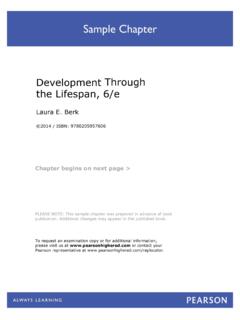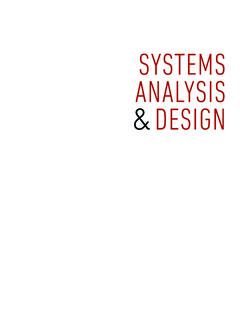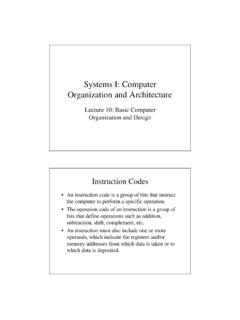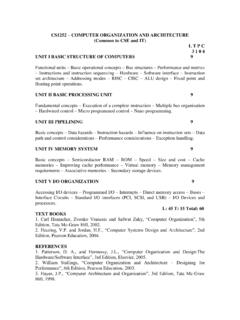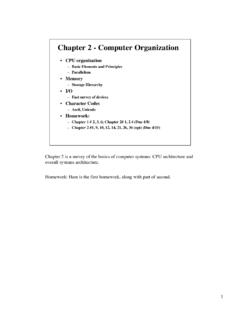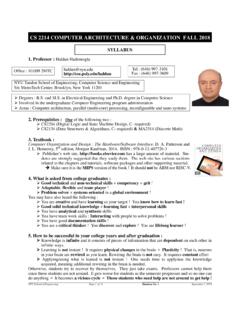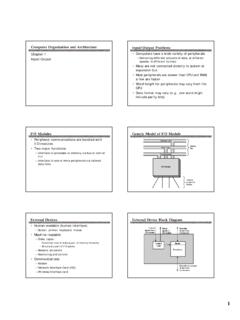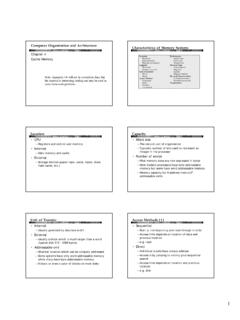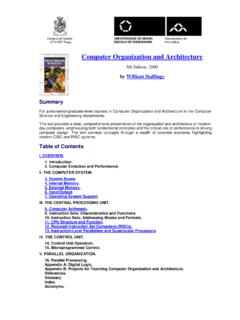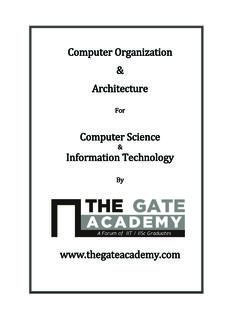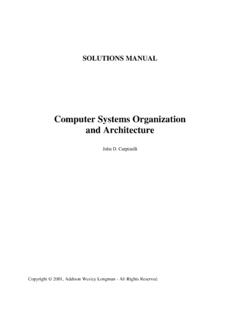Transcription of Computer organization and arChiteCture …
1 Computer organization and arChiteCtureDesigning for Performanceeleventh 11/26/18 9:34 21/26/18 9:34 AMComputer organization and arChiteCtureDesigning for Performanceeleventh editionWilliam Stallings 330 Hudson Street, New York, NY 31/26/18 9:34 AMCopyright 2019, 2016, 2013, 2010, 2006, 2003, 2000 by Pearson Education, Inc., Hoboken, New Jersey 07030. All rights reserved. Manufactured in the United States of America. This publication is protected by copyright and permissions should be obtained from the publisher prior to any prohibited reproduction, storage in a retrieval system, or transmission in any form or by any means, electronic, mechanical, photocopying, recording, or likewise. For information regarding permissions, request forms and the appropriate contacts within the Pearson Education Global Rights & Permissions department, please visit of the designations by manufacturers and seller to distinguish their products are claimed as trademarks.
2 Where those designations appear in this book, and the publisher was aware of a trademark claim, the designations have been printed in initial caps or all caps. The author and publisher of this book have used their best efforts in preparing this book. These efforts include the development, research, and testing of theories and programs to determine their effectiveness. The author and publisher make no warranty of any kind, expressed or implied, with regard to these programs or the documentation contained in this book. The author and publisher shall not be liable in any event for incidental or consequential damages with, or arising out of, the furnishing, performance, or use of these of Congress Cataloging-in-Publication DataNames: Stallings, William, : Computer organization and arChiteCture : designing for performance / William : Eleventh edition. | Hoboken : Pearson Education, 2019.
3 | Includes bibliographical references and : LCCN 0134997190 | ISBN 9780134997193 Subjects: LCSH: Computer organization . | Computer : LCC S73 2018 | DDC dc23 LC record available at Vice President Courseware Portfolio Management: Marcia J. HortonDirector, Portfolio Management: Engineering, Computer Science & Global Editions: Julian PartridgeExecutive Portfolio Manager: Tracy JohnsonPortfolio Management Assistant: Meghan JacobyManaging Content Producer: Scott DisannoContent Producer: Amanda BrandsR&P Manager: Ben FerriniManufacturing Buyer, Higher Ed, Lake Side Communications, Inc. (LSC): Maura Zaldivar-GarciaInventory Manager: Bruce BoundyField Marketing Manager: Demetrius HallProduct Marketing Manager: Yvonne VannattaMarketing Assistant: Jon BryantCover Designer: Black Horse DesignsCover Art: Shuttersstock/Shimon BarFull-Service Project Management: Kabilan Selvakumar, SPi GlobalPrinter/Binder: LSC Communications, : 0-13-499719-0 ISBN-13: 978-0-13-499719-31 41/26/18 9:34 AMTo Triciamy loving wife, the kindestand gentlest 51/26/18 9:34 61/26/18 9.
4 34 AMviiPreface xiiiAbout the Author xxiiPART ONE INTRODUCTION 1 Chapter 1 Basic Concepts and Computer Evolution 1 organization and arChiteCture 2 Structure and Function 3 The IAS Computer 11 Gates, Memory Cells, Chips, and Multichip Modules 17 The Evolution of the Intel x86 arChiteCture 23 Embedded Systems 24 ARM arChiteCture 29 Key Terms, Review Questions, and Problems 34 Chapter 2 Performance Concepts 37 Designing for Performance 38 Multicore, MICs, and GPGPUs 44 Tw o Laws that Provide Insight: Ahmdahl s Law and Little s Law 45 Basic Measures of Computer Performance 48 Calculating the Mean 51 Benchmarks and SPEC 59 Key Terms, Review Questions, and Problems 66 PART TWO THE Computer SYSTEM 72 Chapter 3 A Top- Level View of Computer Function and Interconnection 72 Computer Components 73 Computer Function 75 Interconnection Structures 90 Bus Interconnection 92 Point- to- Point Interconnect 94 PCI Express 99 Key Terms, Review Questions, and Problems 107 Chapter 4 The Memory Hierarchy: Locality and Performance 112 Principle of Locality 113 Characteristics of Memory Systems 118 The Memory Hierarchy 121 Performance Modeling of a Multilevel Memory Hierarchy 128 Key Terms, Review Questions, and Problems 71/26/18 9.
5 34 AMviii ContentsChapter 5 Cache Memory 138 Cache Memory Principles 139 Elements of Cache Design 143 Intel x86 Cache organization 165 The IBM z13 Cache organization 168 Cache Performance Models 169 Key Terms, Review Questions, and Problems 173 Chapter 6 Internal Memory 177 Semiconductor Main Memory 178 Error Correction 187 DDR DRAM 192 eDRAM 197 Flash Memory 199 Newer Nonvolatile Solid-State Memory Technologies 202 Key Terms, Review Questions, and Problems 205 Chapter 7 External Memory 210 Magnetic Disk 211 RAID 221 Solid State Drives 231 Optical Memory 234 Magnetic Tape 240 Key Terms, Review Questions, and Problems 242 Chapter 8 Input/Output 245 External Devices 247 I/O Modules 249 Programmed I/O 252 Interrupt-Driven I/O 256 Direct Memory Access 265 Direct Cache Access 271 I/O Channels and Processors 278 External Interconnection Standards 280 IBM z13 I/O Structure 283 Key Terms, Review Questions, and Problems 287 Chapter 9 Operating System Support 291 Operating System Overview 292 Scheduling 303 Memory Management 309 Intel x86 Memory Management 320 ARM Memory Management 325 Key Terms, Review Questions, and Problems 330 PART THREE ARITHMETIC AND LOGIC 334 Chapter 10 Number Systems 334 The Decimal System 81/26/18 9.
6 34 AMContents ix Positional Number Systems 336 The Binary System 337 Converting Between Binary and Decimal 337 Hexadecimal Notation 340 Key Terms and Problems 342 Chapter 11 Computer Arithmetic 344 The Arithmetic and Logic Unit 345 Integer Representation 346 Integer Arithmetic 351 Floating-Point Representation 366 Floating-Point Arithmetic 374 Key Terms, Review Questions, and Problems 383 Chapter 12 Digital Logic 388 Boolean Algebra 389 Gates 394 Combinational Circuits 396 Sequential Circuits 414 Programmable Logic Devices 423 Key Terms and Problems 428 PART FOUR INSTRUCTION SETS AND ASSEMBLY LANGUAGE 432 Chapter 13 Instruction Sets: Characteristics and Functions 432 Machine Instruction Characteristics 433 Types of Operands 440 Intel x86 and ARM Data Types 442 Types of Operations 445 Intel x86 and ARM Operation Types 458 Key Terms, Review Questions, and Problems 466 Appendix 13A Little-, Big-, and Bi-Endian 472 Chapter 14 Instruction Sets: Addressing Modes and Formats 476 Addressing Modes 477 x86 and ARM Addressing Modes 483 Instruction Formats 489 x86 and ARM Instruction Formats 497 Key Terms, Review Questions, and Problems 502 Chapter 15 Assembly Language and Related Topics 506 Assembly Language Concepts 507 Motivation for Assembly Language Programming 510 Assembly Language Elements 512 Examples 518 Types of Assemblers 523 Assemblers 523 Loading and Linking 526 Key Terms, Review Questions, and Problems 91/26/18 9.
7 34 AMx ContentsPART FIVE THE CENTRAL PROCESSING UNIT 537 Chapter 16 Processor Structure and Function 537 Processor organization 538 Register organization 539 Instruction Cycle 545 Instruction Pipelining 548 Processor organization for Pipelining 566 The x86 Processor Family 568 The ARM Processor 575 Key Terms, Review Questions, and Problems 581 Chapter 17 Reduced Instruction Set Computers 586 Instruction Execution Characteristics 588 The Use of a Large Register File 593 Compiler-Based Register Optimization 598 Reduced Instruction Set arChiteCture 600 RISC Pipelining 606 MIPS R4000 610 SPARC 616 Processor organization for Pipelining 621 CISC, RISC, and Contemporary Systems 623 Key Terms, Review Questions, and Problems 625 Chapter 18 Instruction-Level Parallelism and Superscalar Processors 629 Overview 630 Design Issues 637 Intel Core Microarchitecture 646 ARM Cortex-A8 652 ARM Cortex-M3 658 Key Terms, Review Questions, and Problems 663 Chapter 19 Control Unit Operation and Microprogrammed Control 669 Micro-operations 670 Control of the Processor 676 Hardwired Implementation 686 Microprogrammed Control 689 Key Terms, Review Questions, and Problems 698 PART SIX PARALLEL organization 701 Chapter 20 Parallel Processing 701 Multiple Processors organization 703 Symmetric Multiprocessors 705 Cache Coherence and the MESI Protocol 709 Multithreading and Chip Multiprocessors 718 Clusters 723 Nonuniform Memory Access 726 Key Terms, Review Questions, and Problems 101/26/18 9.
8 34 AMContents xiChapter 21 Multicore Computers 736 Hardware Performance Issues 737 Software Performance Issues 740 Multicore organization 745 Heterogeneous Multicore organization 747 Intel Core i7-5960X 756 ARM Cortex-A15 MPCore 757 IBM z13 Mainframe 762 Key Terms, Review Questions, and Problems 765 Appendix A System Buses 768 Bus Structure 769 Multiple-Bus Hierarchies 770 Elements of Bus Design 772 Appendix B Victim Cache Strategies 777 Victim Cache 778 Selective Victim Cache 780 Appendix C Interleaved Memory 782 Appendix D The International Reference Alphabet 785 Appendix E Stacks 788 Stacks 789 Stack Implementation 790 Expression Evaluation 791 Appendix F Recursive Procedures 795 Recursion 796 Activation Tree Representation 797 Stack Implementation 803 Recursion and Iteration 804 Appendix G Additional Instruction Pipeline Topics 807 Pipeline Reservation Tables 808 Reorder Buffers 815 Tomasulo s Algorithm 818 Scoreboarding 822 Glossary 826 References 835 Index 111/26/18 9:34 121/26/18 9.
9 34 AMxiiiWHAT S NEW IN THE ELEVENTH EDITION Since the tenth edition of this book was published, the field has seen continued innovations and improvements. In this new edition, I try to capture these changes while maintaining a broad and comprehensive coverage of the entire field. To begin this process of revision, the tenth edition of this book was extensively reviewed by a number of professors who teach the subject and by professionals working in the field. The result is that, in many places, the narrative has been clarified and tightened, and illustrations have been these refinements to improve pedagogy and user- friendliness, there have been substantive changes throughout the book. Roughly the same chapter organization has been retained, but much of the material has been revised and new material has been added. The most noteworthy changes are as follows: Multichip Modules: A new discussion of MCMs, which are now widely used, has been added to Chapter 1.
10 SPEC benchmarks: The treatment of SPEC in Chapter 2 has been updated to cover the new SPEC CPU2017 benchmark suite. Memory hierarchy: A new chapter on memory hierarchy expands on material that was in the cache memory chapter, plus adds new material. The new Chapter 4 includes: Updated and expanded coverage of the principle of locality Updated and expanded coverage of the memory hierarchy A new treatment of performance modeling of data access in a memory hierarchy Cache memory: The cache memory chapter has been updated and revised. Chapter 5 now includes: Revised and expanded treatment of logical cache organization , including new figures, to improve clarity New coverage of content-addressable memory New coverage of write allocate and no write allocate policies A new section on cache performance modeling. Embedded DRAM: Chapter 6 on internal memory now includes a section on the increasingly popular 131/26/18 9:34 AMxiv PreFACe Advanced Format 4k sector hard drives: Chapter 7 on external memory now includes discussion of the now widely used 4k sector hard drive format.


